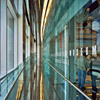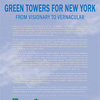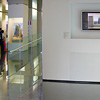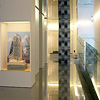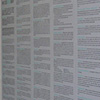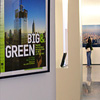The Skyscraper Museum is devoted to the study of high-rise building, past, present, and future. The Museum explores tall buildings as objects of design, products of technology, sites of construction, investments in real estate, and places of work and residence. This site will look better in a browser that supports web standards, but it is accessible to any browser or Internet device.
Introductory Panel
A new crop of skyscrapers is sprouting across the city. This exhibition highlights fourteen projects recently completed, under construction, or in contract that have embraced sustainability and green-building strategies as a central tenet of their design. From high-profile corporate headquarters and speculative office buildings, to innovative mixed-use complexes and apartment blocks, these green towers represent a leading edge of energy efficiency and environmental responsibility in the U.S. today.
Less than a decade ago, America's first "green" skyscraper, the Conde Nast Building at 4 Times Square, was viewed as a visionary experiment and economic gamble. Today, the building industry promotes green goals, and LEED rating (Leadership in Energy and Environmental Design) of Silver, Gold, or Platinum is considered a marketing asset. How did green towers take root in Manhattan, the country's most expensive real estate market, where big buildings can cost a billion dollars?
Pioneers in the most instrumental professions--architects, engineers, and developers, as well as enlightened clients--were of key importance. Advanced technologies, especially in glass and mechanical systems have opened new possibilities of building aesthetics, energy efficiency, health, and comfort. Leadership also came from government through mandatory guidelines, grants, and incentive programs. In 2000, the Battery Park City Authority, which oversees the development and operation of the 92 acres that comprise Battery Park City, instituted rigorous green guidelines for new buildings. Completed in 2003, the Solaire was the first green apartment building in the U. S; since then, four towers have been completed or are under construction, including the one just outside our north window. Green goals also govern the redevelopment at Ground Zero.
With its unnatural canyons of concrete, steel, and glass, New York City is not generally associated with the environmental movement. Yet, by virtue of its many storied workplaces and apartments, shared park space, and almost universal use of public transit, Gotham is a model green community. Measured by energy use per inhabitant, Manhattan is the greenest place in America. If New York City were the fifty-first state, it would rank twelfth in population and last in energy consumption.
Still, as this exhibition demonstrates, New York can do much better if it sets successful standards for sustainable design. Skyscrapers can become intelligent machines that offer healthful interiors and contribute to a cleaner city and global environment. New York's green towers offer a model for the urban future far beyond our borders.
Our Green Glossary, pictured at right, has been made available online.
A new crop of skyscrapers is sprouting across the city. This exhibition highlights fourteen projects recently completed, under construction, or in contract that have embraced sustainability and green-building strategies as a central tenet of their design. From high-profile corporate headquarters and speculative office buildings, to innovative mixed-use complexes and apartment blocks, these green towers represent a leading edge of energy efficiency and environmental responsibility in the U.S. today.
Less than a decade ago, America's first "green" skyscraper, the Conde Nast Building at 4 Times Square, was viewed as a visionary experiment and economic gamble. Today, the building industry promotes green goals, and LEED rating (Leadership in Energy and Environmental Design) of Silver, Gold, or Platinum is considered a marketing asset. How did green towers take root in Manhattan, the country's most expensive real estate market, where big buildings can cost a billion dollars?
Pioneers in the most instrumental professions--architects, engineers, and developers, as well as enlightened clients--were of key importance. Advanced technologies, especially in glass and mechanical systems have opened new possibilities of building aesthetics, energy efficiency, health, and comfort. Leadership also came from government through mandatory guidelines, grants, and incentive programs. In 2000, the Battery Park City Authority, which oversees the development and operation of the 92 acres that comprise Battery Park City, instituted rigorous green guidelines for new buildings. Completed in 2003, the Solaire was the first green apartment building in the U. S; since then, four towers have been completed or are under construction, including the one just outside our north window. Green goals also govern the redevelopment at Ground Zero.
With its unnatural canyons of concrete, steel, and glass, New York City is not generally associated with the environmental movement. Yet, by virtue of its many storied workplaces and apartments, shared park space, and almost universal use of public transit, Gotham is a model green community. Measured by energy use per inhabitant, Manhattan is the greenest place in America. If New York City were the fifty-first state, it would rank twelfth in population and last in energy consumption.
Still, as this exhibition demonstrates, New York can do much better if it sets successful standards for sustainable design. Skyscrapers can become intelligent machines that offer healthful interiors and contribute to a cleaner city and global environment. New York's green towers offer a model for the urban future far beyond our borders.
Our Green Glossary, pictured at right, has been made available online.

